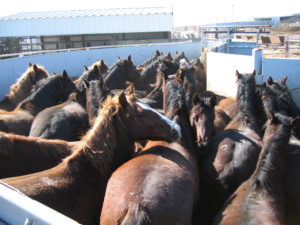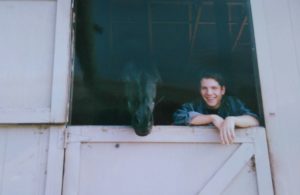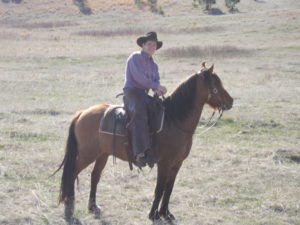The Mustang Mess

Members of Congress in Washington–not the BLM managers–will decide what happens to these mustangs in the next month. Feral horse herd overpopulation has presented range management and financial management difficulties.
This month, the House Judiciary Committee will vote on the 2018 budget, including how funds will be allocated to care for the growing number of wild horses (mustangs) that live on federal lands. There are ardent defenders on both sides of the argument of how the tax-payers money should be spent. No real solution has been presented yet so the problem (along with the population of the horses) has only gotten bigger.
First, it is helpful to define the term, “wild.” The horses that have become the topic of debate (namely the North American Mustangs) are not truly wild horses. The only true wild horses in the world are the Przewalski horses of Mongolia. They may be compared to wild game, like elk or zebras (though zebras and horses come from the same family [Equidae] they are not the same species and thus it is not accurate to say that zebras are wild horses). The free-roaming mustangs of the American West are feral horses or in other words, horses that have descended from domesticated ancestry. They may be compared to untamed housecats running loose in the woods. People probably wouldn’t marvel at a stray cat in the woods, but for some reason, the mustangs have captured the imagination of naïve Americans for better or worse.
Next, a brief history of the mustangs is insightful. Most scientists agree that the type of horse we are familiar with today was introduced to the Americas by Christopher Columbus in 1493 on his second voyage. The origins of the North American Mustang were not wild!
As years went on, these once domesticated horses were either neglected or “set free.” They began to freely roam the country and procreate unchecked. Today it is estimated that without any sort of population control, horse herds will double every four years.
Populations of these feral herds were traditionally thinned by Native American Indians, pioneers and ranchers. They would capture the horses and employ them for domestic use. America was not yet industrialized so the need for horses was great. Also lack of civilization contributed to an abundance of natural predators like mountain lions and wolves which also cut down herd numbers.
As America grew and technology advanced, the need—not the want—for horses went down. There were also fewer natural predators of the mustangs. Domesticated breeds of horses became popular due to their higher heritability and tractability. Naturally, population density of the feral horses grew.

“Diablo” was trained through the prison program in Colorado. Pictured here when I was about 17 years old.
The population was then curbed by euthanizing the surplus horses. This came to an end when Congress passed and President Richard Nixon signed the Wild and Free-Roaming Horses and Burros Act of 1971. This law protects feral herds and prohibits their slaughter. The Bureau of Land Management (BLM) and the Forest Service manage these herds. The plan was then to remove a certain amount of horses every year and allow the public to adopt the mustangs. This worked well for a while but over time more were coming in than were going out. Programs like the Wild Horse Inmate Program (WHIP) and Mustang Makeover have had positive influences on mustang adoptions.
I have had personal experience with mustangs. When I was growing up, our family received a mustang from the inmate program (where prison inmates train mustangs as a rewardfor good behavior). The horse was named Diablo and he was one of my favorite horses. He had been trained well but he required focused attention while riding or he would take advantage of the rider’s inattentiveness. He had a lot of heart. Once while riding in a rocky area, he stalled because he couldn’t find a way out of the way we had come. I got off and led him out of the hazardous situation. I earned his trust that day and he never forgot it. He willingly went anywhere I directed after that.
A few years ago, Butler Professional Farrier School adopted several BLM mustangs because we wanted students to have the opportunity to improve their horsemanship. While many of the mustangs became some of the best horses at the school, a lot of them also went the other way. Mustangs are not guaranteed good, trustworthy horses. There is some truth to the fact that they are “clean slates” with no bad habits to break, but some of the mustangs were just too determined to stay wild. They were dangerous. Many of them injured themselves and others.

“Houdini” is a mustang that I was able to train from start to finish or “from the ground up”. He is one of the smartest horses I’ve ever known. My experience has been that not all mustangs share his good personality and tractability.
I got my favorite horse from this group of mustangs. His name is Houdini. He is the smartest horse I’ve ever ridden and he has a lot of heart and willingness to please. I trust him enough to let my wife ride him now. But he started out very wild. Because of him, I ended up in the hospital in his early training! This is too much work and too great a risk for most sane people. There are plenty of easier, safer ways to obtain quality horses, so the mustangs have largely been left alone. As people have discovered this for themselves, fewer adoptions have taken place. In recent years the population has become almost unmanageable.
With overpopulation, feed and care are major concerns. If 600 housecats were left in an old abandoned barn with only 3 mice in it, there would be a big problem. The vast majority of the animals would starve. This is happening to the mustangs. Well-meaning but ignorant lawmakers will not allow these animals to be destroyed but they also won’t come up with a solution for their care. Caretakers have a responsibility to not only protect life but also provide a quality life for the animals that the land can support. This is not possible with massive numbers of horses in the same area.
John Ruhs, the BLM director in Nevada, estimates they have three times the number of horses that the range can adequately support. There are approximately 72,000 horses on land that can only handle about 26,715 horses. (Siegel, J. Washington Examiner. 5 Dec 2017)
Not only is it a land management problem, but a financial one as well. In addition to 72,000 horses on the range, the BLM also cares for 45,000 horses that have been removed from the wild and put into feedlots and sanctuaries. It is estimated that these horses will cost over $1 billion dollars to sustain over their lifetimes.
BLM directors are in a tight spot because they can only do what the law dictates they can do. Congressman Christ Stewart from Utah says, “Although the finger is routinely pointed at the B.L.M. for mismanagement, the bulk of the blame lies with shortsighted decision-making by misinformed but well-meaning members of Congress.” (Stewart, C. New York Times. 25 Dec 2017)
The House of Representatives has an opportunity now to change this. They will vote on the 2018 budget in January and Congressman Stewart has proposed that the language be removed regarding the prohibition of selling these animals to slaughterhouses.
Of course, there has been opposition from the animal rightists, but they offer very little in terms of alternative solutions. Birth control is a popular theory but unrealistic when it comes to implementation. The PZP (porcine zona pellucid) vaccine is an effective contraceptive for one year and costs between $10 to $25 per treatment. That could mean from $720,000 to $1.8 million dollars per year for birth control alone.
Unfortunately, there are too many horses and not enough resources to care for them. Supply has gone up and demand has gone down. This has had a chilling effect on other horse markets as well. Simply keeping the horses alive has not improved their quality of life. If the BLM is allowed to manage these feral herds better by euthanizing the excess horses that are starving to death, it will better the quality of life for the mustangs in the long term.
Related Posts
-
Shoeing horses is not just about taking care of horses. We n...Aug 01, 2019 / 0 comments
-
Farriers perform a valuable service for people who care abou...Jan 15, 2010 / 0 comments
-
By Doug Butler, PhD, CJF, FWCF Farriery or horseshoeing is a...May 24, 2018 / 0 comments
Blog Categories
- Anatomy
- Best Business Practices
- Conformation
- Current Events
- Customer Service
- Draft Horse Shoeing
- Equine Soundness
- Essential Anatomy Kit
- Farrier Careers
- Farrier training
- Foal soundness
- Horse Care
- Horse Foot Care
- Horse Owner Tips
- Horsemanship
- Horseshoeing
- Horseshoeing History
- Iron and Forge Work
- Student Spotlight
- Uncategorized
- Veterinary Care
Blog Archives
Contact Us
Butler Professional Horseshoeing School
495 Table Road
Crawford, NE 69339
(800) 728-3826
jacob@dougbutler.com
Subscribe to Our Blog
Get Our Free e-Book!
If you think you want to become a farrier (or know someone who does), this book can help you make that decision. Horse owners will learn the importance of choosing a qualified farrier and how to select the “right” one.
[ Get the e-Book Now! ]
- Follow:
